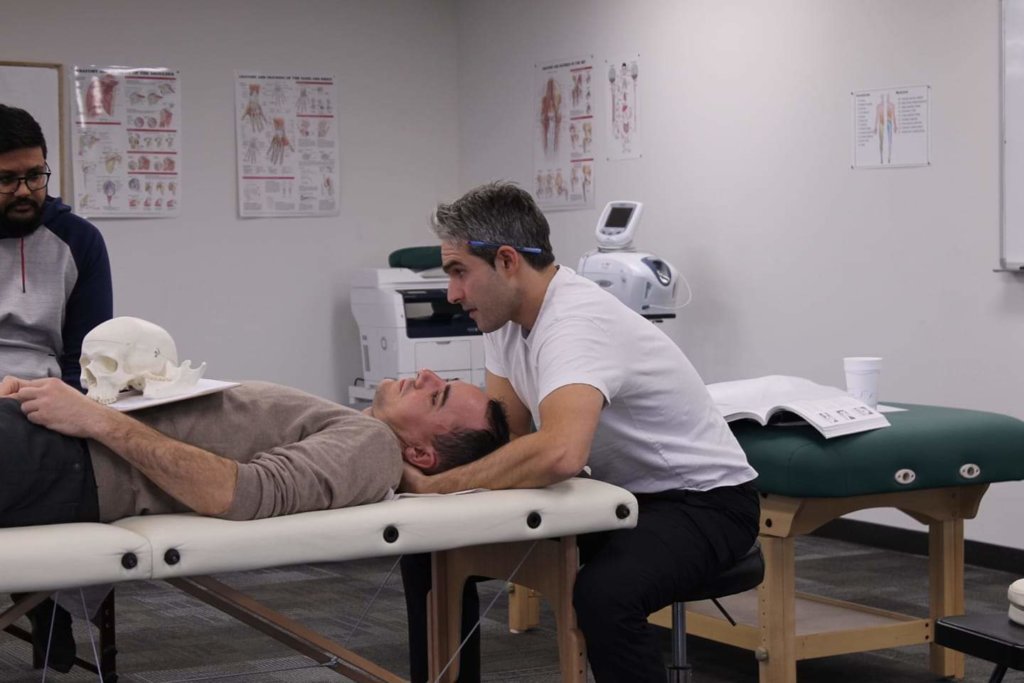
OSTEOPaTHIC TREATMENT
click this text to view a video of treatment
What Injuries can osteopathy help with?
Osteopathic manual treatment (OMT) is used to treat many forms of bodily dysfunction including pain, discomfort and limited range of motion caused by illness or injury. The goal of OMT is to remove these barriers in order to achieve wellness.
OMT can be applied to many types of injuries, issues and aliments.
Back pain
Neck painInjury recoveryPostural issuesDegenerative jointsShoulder painStrokeMultiple Sclerosis
Disc herniation
Stress headachesMigrainesConcussionsMulti-level vertebral spinal injuriesScoliosisSleep disordersMany other types of issues
Osteopathy Is a form of manual therapy that uses hands on touch to assess the known and for unknown restrictions effecting the bones, joints, nerves, muscular and connective tissue of the body. Once a restriction(s) has been identified a variety of gentle hands on techniques are used until the restriction(s) disappears or greatly reduces.
But what does that mean?
Well, In every injury that occurs to the body there is the development of strains, twists and distortions in fascia, ligaments, or muscle fibers. These mechanical changes will effect the function of muscles, bones, joints, and nerves which can prolong the recovery process or make the rehabilitation process more painful. In the practice of Osteopathy, over the course of treatment we use our various techniques to ease or reduce the mechanical changes to help return the various structures of the body back towards their optimal functioning for the improvement in your quality of life
Techniques in Osteopathy;
Below is a list of a few of the over 40 specific techniques we are trained in to help improve the function of the body. I encourage you to google some of these terms and learn how they may help you. Typically a treatment session ranges from 45 minutes - 1 hour. Numerous techniques may be used during an individual session.
Articulatory Technique
Balanced Ligamentous Tension
Chapman Reflex
Strain Counter -Strain
Facilitated Positional Release
Fascial Unwinding
Muscle Energy
Myofascial Release
Pedal Pump
Positional release therapy
Cranial Osteopathy
Soft Tissue Technique
Still Technique
Traction Technique
Visceral Manipulation
Lymphatic Pump
many other techniques
The E.L.D.O.A are postural exercises that you can do yourself with the primary goal being to increase the space within chosen joints . As the E.L.D.O.A “create” space, there is an improvement in:
Joint mechanics
Range of motion
Reduction of pain
Improved posture
Reduced pressure on the discs and nerves of the spine
Better muscle tone
Elongate muscle tissues
There’s a long list of benefits
e.L.D.O.A Training
How is E.L.D.O.A Learned
E.L.D.O.A exercises are learned at a group class or through individual training.
An E.L.D.O.A group class is 60 minutes in length. At the beginning of class, range of motion and orthopedic test are preformed after which a series of E.L.D.O.A exercises will be taught to the group.
E.L.D.O.A one on one.
The private training in E.L.D.O.A offers a completely tailored experience that includes recordings and manuals to aid you in your home practice of your needed E.L.D.O.A(s)
How E.L.D.O.A works
Through positioning of your arms, legs and spine. A specific joint can be made the center of “separating forces.” As tension generates during the holding of a E.L.D.O.A there becomes an improvement in the structure and function of the chosen region.
A E.L.D.O.A repetition is held typically for 60 seconds. Often a person will have a cluster of E.L.D.O.A. assigned with a specific number of repetitions recommended for home practice.
Online Programs
Healthy Spine Programs
I have created and organized numerous instructional videos which demonstrate exercises that aid you in rehabbing from a variety of types of pains which affect the muscles, bones, joints and nerves of the body.
If you suffer from any of the below listed problems there is an easy to follow instructional video to help you resolve the problem.
Radiating pain that travels down the leg
Pain that is localized to your back
Feeling of leg instability (buckling, giving way)
Disturbed sleep patterns due to pain
Unable to sit for long periods due to pain
Pain going from sitting to standing
Difficulty driving because of pain
Sharp or Nagging pain in the neck and shoulders
Tingling and numbness in the upper limbs.
Many other types of bodily pains


